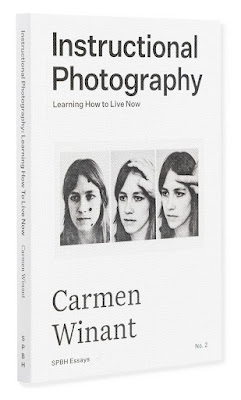 |
By Carmen Winant
|
Learning How to Live Now
Artist's book by Carmen Winant
SPBH Editions, 2021. 96 pp., 48 illustrations, 4¼x5¾x½".
Carmen Winant coins a novel term, “Instructional Photography,” with the title of her new book. Her neologism is so apt that it doesn’t even strike me as new. The term is as forthright and instrumental as the photographs themselves.
Winant collects, collages, and re-presents photographs from how-to manuals in this book, as in her larger practice. There are instructions in aerobics, ceramics and rock climbing, as well as pictures from the literature of medicine and sexuality. The key feature of an instructional photograph is its promised relation to a viewer’s body. In long view and in close-up, models demonstrate their tasks. Their bodies stand-in for the viewer’s body. We are meant to mirror their poses, whether learning how to shape pottery or practice self-defense.
It’s a small book that makes a big claim: that instructional photographs don’t just teach viewers how to accomplish a given task, but that, as a whole, the genre is a guide to living. As Winant puts it in the subtitle, they are a guide for “Learning How To Live Now.”
 |
Immediately her tone is convincing: “In a moment — we might agree? — of heightened anxiety and re-imagination, I want, on these pages and together, to investigate the potential of photography to teach us how to live.” I cannot resist her first-person plural aside, nor the insistence of her italics. I do agree; I want to learn. Like John Berger’s Ways of Seeing, Winant makes her point through the combined rhetorical logic of words and pictures. She uses the form of the how-to book — a small, hand-held object — to emphasize its familiarity. We are, in effect, reading an instructional book about instructional photography.
Winant’s argument is bigger, though, than just defining the genre. She suggests that all photographs are instructional. She asks, “Don’t artists too believe we have something to ‘teach’ with and through our work?”
With all the visual intelligence of a photobook editor, Winant’s page breaks underscore her argument in words and pictures. Like a poet, Winant gets in your head. Like instructional photographs themselves, the interaction demanded by her book — read the words, turn the page, read the images as words — makes this promise real. In neuroscience, this relationship between bodies is described as kinesthetic empathy. Watching a body perform a task, we can feel the motion in our own bodies. In Winant’s book, this is most effective in the full-bleed sequences that unfold over several pages. Like the still photographs that take on a sense of movement in Chris Marker’s La Jetée, photographs of a woman seated and back-lit on a patio become uncannily live as I turn the pages.
 |
 |
Winant amplifies this experience of connection by giving the viewer control over the pacing. You turn the page, you create the movement, you decide to go forward or backwards in time. You also choose to inhabit the image, to imagine yourself into it. There’s a powerful movement from self-recognition to self-actualization in these images. Winant admits that such grand hopes for photographs are often dismissed as “didactic” in art school. They are too obvious.
But, what they also do — and what Winant’s book does — is make a gift of themselves. They are literally self-sacrificing, in that they make an image of the self available to others. They promise the image of the body as a container, a shelter for others to inhabit. But they are also endlessly renewable. I might inhabit this body for a moment in my mind, I might feel its sensations in my own body, but it’s also available to others who study it. We can try on new ways of doing and new ways of being with others in the world through instructional photography. I agree; ‘in a moment… of heightened anxiety and re-imagination,’ I hungrily turn to art like Winant’s for instruction in life.
Purchase Book
Read More Book Reviews
 |
 |









